Google Analytics goal tracking provides site owners and marketers with good information about how visitors are using and interacting with pages and content. This information may ultimately help businesses earn more.
In the ecommerce context, it is important to make a distinction between goal tracking and ecommerce tracking in Google Analytics. The latter monitors actual ecommerce transactions and requires relatively more integration with an ecommerce platform. The former, which is this article’s focus, monitors how visitors interact with a site in four general ways.
-
Destination tracking. Counts a goal conversion when a user visits a particular page or set of pages.
-
Duration tracking. Converts when a visitors interacts with the site for a specified amount of time.
-
Pages or screens per session tracking. Converts when a visitor interacts with a given number of pages or screens.
-
Event tracking. Converts when a user completes an action like viewing a map or watching a video. Event tracking also takes some advanced configuration, so it goes a bit beyond the basics described in this article.
Why Google Analytics Goals Are Important
Goal tracking in Google Analytics is simply a tool that helps site owners and marketers decide if their site content, features, or capabilities are contributing to established business goals.
An example might help. Imagine an online retailer that, as a company, has decided to grow its list of email subscribers. It puts a new “subscribe” button on the home page. Certainly, this company could count the number of new subscribers using a report from its email solutions provider. But Google Analytics goal tracking could add to the analysis, providing a conversion rate or even tracking the path visitors took before converting.
Taking the example further, the retailer might also have a newsletter subscription form on blog pages. With goal tracking it would be possible to compare the number of conversions from the home page to the number of conversions from blog pages. The average conversion rate could be compared too, possibly providing insights that would let the retail business optimize its subscription form.
Similarly, Google Analytics goal tracking could be used to monitor traffic flow through the site, the value of advertising, or even how much impact social media marketing is having.
How to Set Up a Goal in Google Analytics
With Google Analytics open, navigate to the Admin section, which is typically divided into three columns: Account, Property, and View. In the View column, there is a link for Goals.
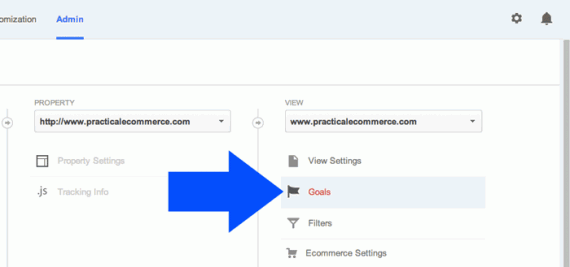
Find the Goals link in the third column of the Admin Section.
When the next page loads, you will have an opportunity to create a new goal. There is a form that allows you to name the goal and begin the process of setting it up. This form will also provide a goal ID and a goal set. If this is your first goal, these will both be set to one.
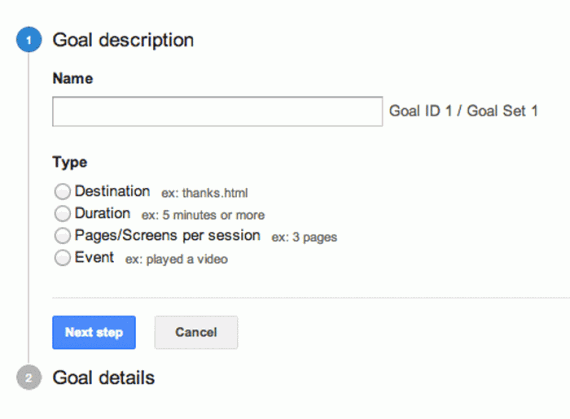
Name your goal and specify what should be measured. Notice the Goal ID and goal set.
The goal form gives you the four measurement options described earlier in this article: destination, duration, pages or screens per session, and events.
Destination Goals
Destination goals work best when you want to learn what percentage of site visitors are landing on a particular page. For example, an online wholesaler that uses ecommerce to sell business-to-business may require visitors to register and get approval before its site will display prices. If this retailer wanted to track a conversion rate for the registration page, it could do it with a destination goal.
To track these registrations, the B2B wholesaler would need to know the URL for the registration form completion page. For the sake of example, imagine that URL is http://somedomain.com/registration/success.
To set up the destination goal, this B2B wholesaler would enter “/registration/success” in the destination field in the goal’s configuration form. Notice that it is not necessary to include the protocol, “http://”, or the domain name.
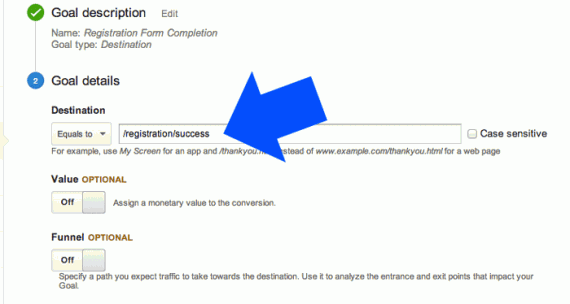
Destination goals track a conversion when a visitor interacts with a specified page or screen.
By default the destination field will be set to “Equal to,” which looks for an exact match. It is also possible to use “Begins with,” for a destination URL that may have additional and variable information at the end, or a regular expression, which can be used to match a set of pages.
Google Analytics allows you to set a value for this conversion, so if the B2B wholesaler knew that a typical registered user was worth about $500, it could assign a $500 conversion value, and Google Analytics would report on it.
Finally, it is also possible to set up a funnel. This would be a list of URLs that you imagine a visitor will step through on the way to a destination goal.
Duration Goals
As the name suggests, duration goals convert when a visitor stays on site for some particular amount of time.
This sort of goal tracking might be helpful for an online retailer focused on content marketing. In this case, the retailer is trying to provide shoppers with useful or entertaining site content with the hope of building lasting relationships. Perhaps, the retailer has a goal of keeping visitors engaged with content for at least three minutes. A Google Analytics duration goal would count the number of engaged visitors and provide a conversion rate. With a bit of digging in Google Analytics’ various reports, the retailer could find that combination of pages that converts best.
The duration goal form requires only that you specify the number of hours, minutes, or seconds that you want the user to stay on the site. It is possible to associate a dollar value with the duration conversion.
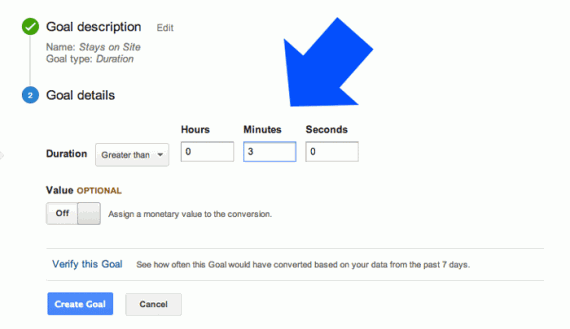
Enter the number of hours, minutes, or seconds you want visitors to stay on site to set up a duration goal.
Pages or Screens per Session Goals
Another way to monitor engagement is to figure out how many pages or screens a visitor interacts with for a particular session (visit). This sort of conversion tracking could help a site owner better understand how content works together to provide an overall user experience.
To set up a pages or screens per session goal, simply tell Google Analytics how many pages or screens a visitor sees before a conversion is counted.
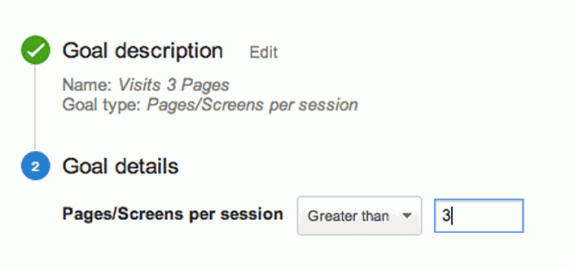
The pages or screens per session goal type converts when a visitor interacts with the specified number of pages or screens.
Viewing Goals in Reports
Once you have goals created, these goals may be used as dimensions in many if not most of Google Analytics reports, so you can learn if geography or time of day impacts goal conversions.





